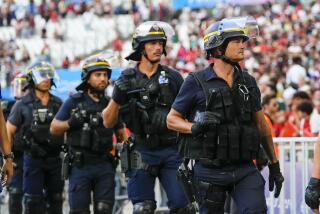7 planes targeted in ’06 plot, court told
- Share via
LONDON — A 2006 plot to blow up passenger jets over the Atlantic could have resulted in the near-simultaneous detonation of seven Boeing 777s, with authorities having no means of halting “an act of terrorism on an almost unprecedented scale” once it was underway, prosecutors said Thursday.
As a trial opened for eight Britons accused of hatching the plot, prosecutors for the first time laid out evidence in a now-infamous scheme that paralyzed airports on both sides of the Atlantic and ended the era when passengers could pass through airport security with a soft drink or a large bottle of shampoo.
At least seven flights were targeted, leaving at midafternoon from London’s Heathrow Airport for New York, Washington, Chicago, Toronto, Montreal and San Francisco, prosecutor Peter Wright told jurors.
“Therefore, barring unexpected cancellation or lengthy delay, seven passenger aircraft carrying hundreds of passengers and crew depart Heathrow Airport entirely at the mercy of the suicide bombers who happen to be on board with their deadly devices,” Wright said.
The trial is expected to last as long as eight months for the men, many of them strongly observant Muslims, who hail mainly from suburban communities around Britain such as Walthamstow and High Wycombe.
No charges have been filed in Britain in the current case against Rashid Rauf, a British-Pakistani citizen believed to have links to extremist groups in Pakistan. His arrest in Pakistan apparently triggered the roundup of the suspects in Britain. Rauf’s brother was one of 24 suspects initially taken into custody, but was subsequently released without charge.
All eight men have pleaded not guilty to charges that include conspiracy to murder, preparing acts of terrorism and, in at least one case, possession of illegal firearms. According to the charges, at least one defendant had a book on improvised explosive devices, suicide notes, wills and a map of Afghanistan.
The majority of the prosecution’s case is expected to be laid out today, but in an initial overview Thursday, Wright also detailed how the suspects are believed to have planned to disguise bombs as bottles of soft drinks in order to smuggle them through airport security.
Details of the North America-bound flight schedules and information about baggage restrictions at Heathrow were on a computer memory stick found in the pocket of one of the alleged ringleaders, Ahmed Abdullah Ali, 27, when he was arrested, the prosecution said. Wright also showed the jury a small address book that authorities say was found in Ali’s possession that contained lists of items investigators believe were the components needed to assemble liquid bombs.
“Clean batteries, disguise . . . drink bottles . . . check time to fill each bottle,” the list said. “Decide on which battery to use for D. Small is best. . . . Select date. Five days before. All link up, prepare. . . .
“One drink use. Other keep in pocket maybe will not get through . . . plus keys and chewing gum . . . cameras take. The drinks that you should drink should be different flavr [sic].”
Potentially explosive quantities of hydrogen peroxide, the prosecutor said, were to be mixed with a fruit-flavored drink powder, then injected by hypodermic needle into the bottom of plastic drink bottles to make it appear as though the bottles were unopened when they were taken through security.
Small AA batteries, he said, were to be emptied and refilled with a homemade detonating compound, which would then be set off with something such as a disposable camera flash.
Ali was arrested when he drove to a parking lot near his house to meet with another man authorities have identified as one of the ringleaders, defendant Assad Sarwar, 28.
The other defendants are Tanvir Hussain, 27; Mohammed Gulzar, 26; Ibrahim Savant, 27; Arafat Khan, 26; Waheed Zaman, 23; and Umar Islam, 29.
--
More to Read
Sign up for Essential California
The most important California stories and recommendations in your inbox every morning.
You may occasionally receive promotional content from the Los Angeles Times.










